
NGC 5921 is a barred spiral galaxy located approximately 65 million light-years from the Solar System in the constellation Serpens Caput. It was discovered by William Herschel on 1 May 1786. In February 2001 a type II supernova was discovered in NGC 5921. It is a member of the Virgo III Groups, a series of galaxies and galaxy clusters strung out to the east of the Virgo Supercluster of galaxies.
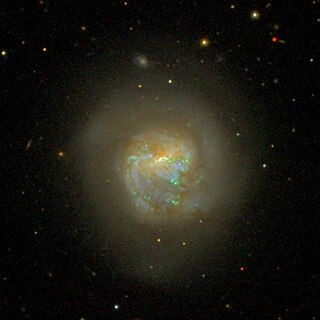
NGC 5713 is a peculiar, asymmetric galaxy in the constellation Virgo. Although classified as a spiral galaxy by most galaxy catalogs, NGC 5713 is very different from most normal spiral galaxies. While most spiral galaxies either have either two well-defined spiral arms or a filamentary spiral-like structure, this spiral galaxy has only one visible spiral arm in its disk. This makes it a galaxy of the Magellanic type. Gravitational interactions with the nearby spiral galaxy NGC 5719 may be responsible for producing the disturbed, asymmetric structure including the single spiral arm.

NGC 5300 is a face-on spiral galaxy in the constellation Virgo. It is a member of the NGC 5364 Group of galaxies, itself one of the Virgo III Groups strung out to the east of the Virgo Supercluster of galaxies.
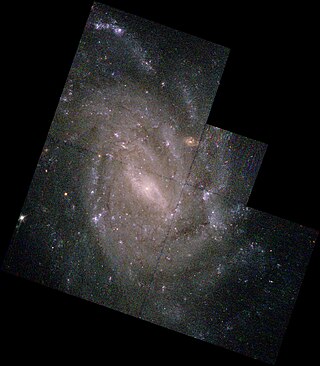
NGC 5334 is a face-on spiral galaxy in the constellation Virgo. It is a member of the Virgo III Groups, a series of galaxies and galaxy clusters strung out to the east of the Virgo Supercluster of galaxies.

NGC 5364 is a grand design spiral galaxy located 54.5 million light years away in the constellation Virgo. It is inclined to the line of sight from the Earth at an angle of 47° along a position angle of 25°. It is a member of the NGC 5364 Group of galaxies, itself one of the Virgo III Groups strung out to the east of the Virgo Supercluster of galaxies.

NGC 5750 is a barred spiral galaxy with an active galactic nucleus in the constellation Virgo. It was discovered on April 11, 1787 by the astronomer William Herschel. It is a member of the NGC 5746 Group of galaxies, itself one of the Virgo III Groups strung out to the east of the Virgo Supercluster of galaxies.

NGC 4420 is an unbarred spiral galaxy located 77 million light-years away in the constellation Virgo. It is a member of the M61 Group of galaxies, which is a member of the Virgo II Groups, a series of galaxies and galaxy clusters strung out from the southern edge of the Virgo Supercluster.
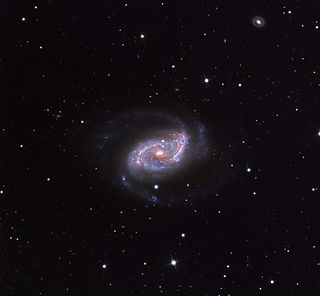
NGC 5248 is a compact intermediate spiral galaxy about 59 million light-years away in the constellation Boötes. It is a member of the NGC 5248 Group of galaxies, itself one of the Virgo III Groups strung out to the east of the Virgo Supercluster of galaxies. Distance measurements to NGC 5248 vary from 41.4 million light-years to 74.0 million light-years, averaging about 58.7 million light-years.
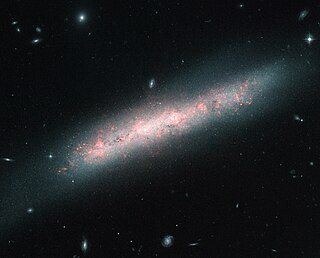
NGC 4700 is a spiral galaxy located about 50 million light years away in the constellation of Virgo. NGC 4700 was discovered in March 1786 by the British astronomer William Herschel who noted it as a "very faint nebula". It is a member of the NGC 4699 Group of galaxies, which is a member of the Virgo II Groups, a series of galaxies and galaxy clusters strung out from the southern edge of the Virgo Supercluster.

NGC 5566 is a barred spiral galaxy in the constellation Virgo, which is approximately 65 million light years away from Earth. The galaxy is the biggest in the constellation Virgo, stretching nearly 150,000 light years in diameter. The galaxy NGC 5566 was discovered on 30 April 1786 by the German-British astronomer William Herschel. It is included in Halton Arp's Atlas of Peculiar Galaxies. It is a member of the NGC 5566 Group of galaxies, itself one of the Virgo III Groups strung out to the east of the Virgo Supercluster of galaxies.

NGC 4517 is a spiral galaxy located approximately 40 million light-years away in the constellation of Virgo. It was discovered in 1784 by William Herschel. It is a member of the Virgo II Groups, a series of galaxies and galaxy clusters strung out from the southern edge of the Virgo Supercluster.

NGC 4527 is a spiral galaxy in the constellation Virgo. It is a member of the M61 Group of galaxies, which is a member of the Virgo II Groups, a series of galaxies and galaxy clusters strung out from the southern edge of the Virgo Supercluster.

NGC 5774 is an intermediate spiral galaxy approximately 71 million light-years away from Earth in the constellation of Virgo. It was discovered by Irish engineer Bindon Stoney on April 26, 1851.
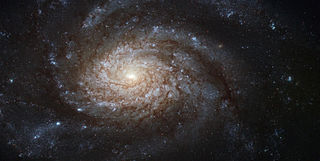
NGC 3810 is a spiral galaxy located in the constellation Leo. It is about 50 million light years from Earth, and estimated to be about 60,000 light years in diameter. William Herschel discovered it on 15 March 1784.

NGC 5468 is an intermediate spiral galaxy located in the constellation Virgo. It is located at a distance of about 140 million light-years from Earth, which, given its apparent dimensions, means that NGC 5468 is about 110,000 light-years across. It was discovered by William Herschel on March 5, 1785.

NGC 5363 is a lenticular galaxy located in the constellation Virgo. It is located at a distance of circa 65 million light years from Earth, which, given its apparent dimensions, means that NGC 5363 is about 100,000 light years across. It was discovered by William Herschel on January 19, 1784. It is a member of the NGC 5364 Group of galaxies, itself one of the Virgo III Groups strung out to the east of the Virgo Supercluster of galaxies.
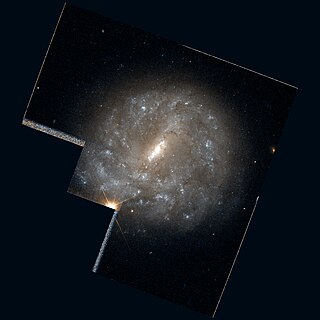
NGC 4900 is a barred spiral galaxy in the constellation Virgo. It was discovered by William Herschel on April 30, 1786. It is a member of the NGC 4753 Group of galaxies, which is a member of the Virgo II Groups, a series of galaxies and galaxy clusters strung out from the southern edge of the Virgo Supercluster.

NGC 4781 is a barred spiral galaxy in the constellation Virgo. It was discovered by William Herschel on Mar 25, 1786. It is a member of the NGC 4699 Group of galaxies, which is a member of the Virgo II Groups, a series of galaxies and galaxy clusters strung out from the southern edge of the Virgo Supercluster.

NGC 4731 is a barred spiral galaxy located near the Virgo supercluster. To its celestial south lies NGC 4731A, a small irregular galaxy. Both galaxies feature high concentrations of neutral HI gas. It is theorized that its elongated arm structure could be related to gravitational interactions with a nearby galaxy, NGC 4967. It is a member of the NGC 4697 Group of galaxies, which is a member of the Virgo II Groups, a series of galaxies and galaxy clusters strung out from the southern edge of the Virgo Supercluster.

The Virgo III Groups, or Virgo III Cloud, are a series of at least 75 galactic clusters and individual galaxies stretching approximately 40 megalight-years off the eastern edge of the Virgo Supercluster. Parts of it are in the constellations Virgo, Libra, and Serpens Caput. It is located approximately 65 Mly (19,929,090.60 pc) to 85 Mly (26,061,118.47 pc) from the Solar System, at a right ascension of 13h 30m to 15h 20m.




















